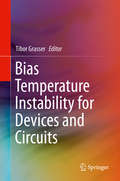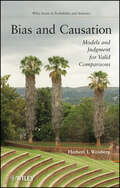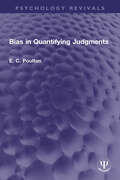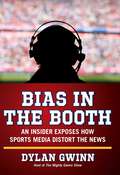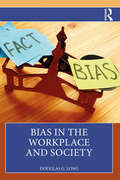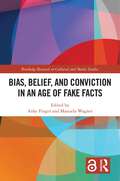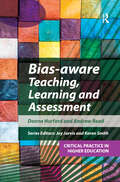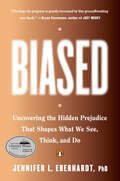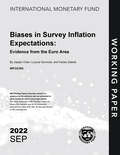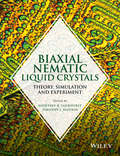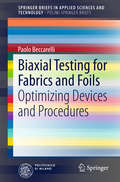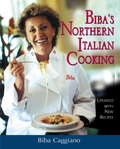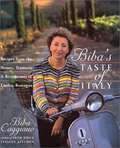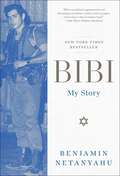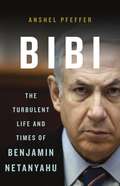- Table View
- List View
Bianco: Pizza, Pasta, and Other Food I Like
by Chris BiancoWhen Chris Bianco started Pizzeria Bianco in the back corner of a Phoenix grocery store in 1988, he had no idea that he would become a driving force in the artisanal pizza movement. All he knew was that his food would reflect the respect and sincere intention that he brings to each of his recipes, as the result of his relationships with farmers, local producers, customers, and staff. Now a James Beard Award–winning chef—the first pizzaiolo to receive the honor—and the owner of the legendary pizza mecca, Chris Bianco brings us a full- color, fully illustrated cookbook that illuminates the fundamentals of pizza making and the philosophy behind Chris’s cooking. The book features recipes for his signature pizzas as well as strategies and techniques for translating chef’s methods to the home kitchen. Bianco celebrates both the simple and the nuanced, revealing the methods that lead to the perfect crust, the sweetest tomato sauce, the creamiest mozzarella, and the most expertly balanced flavor combinations. It also features recipes for salads, antipasti, and dessert options, as well as family meals that are cooked behind the scenes and a new array of big plates showcased at Chris’s highly regarded restaurants. With its attention to detail and tips for making unforgettable, flavorful pizzas, Bianco is an essential manual for anyone serious about pizza, pasta, and more.Chris Bianco is the chef-owner of Pizzeria Bianco, with locations in Phoenix, Arizona, as well as Pane Bianco and his new white-tablecloth restaurant Tratto, also in Phoenix. Bianco won the James Beard Award for Best Chef Southwest in 2003 and helped spawn a generation of independent and artisanal pizzerias, lending his advice, wisdom, and food philosophies to dozens of fellow chefs and restaurateurs.
Bias Temperature Instability for Devices and Circuits
by Tibor GrasserThis book provides a single-source reference to one of the more challenging reliability issues plaguing modern semiconductor technologies, negative bias temperature instability. Readers will benefit from state-of-the art coverage of research in topics such as time dependent defect spectroscopy, anomalous defect behavior, stochastic modeling with additional metastable states, multiphonon theory, compact modeling with RC ladders and implications on device reliability and lifetime.
Bias and Causation
by Herbert I. WeisbergA one-of-a-kind resource on identifying and dealing with bias in statistical research on causal effects Do cell phones cause cancer? Can a new curriculum increase student achievement? Determining what the real causes of such problems are, and how powerful their effects may be, are central issues in research across various fields of study. Some researchers are highly skeptical of drawing causal conclusions except in tightly controlled randomized experiments, while others discount the threats posed by different sources of bias, even in less rigorous observational studies. Bias and Causation presents a complete treatment of the subject, organizing and clarifying the diverse types of biases into a conceptual framework. The book treats various sources of bias in comparative studies--both randomized and observational--and offers guidance on how they should be addressed by researchers. Utilizing a relatively simple mathematical approach, the author develops a theory of bias that outlines the essential nature of the problem and identifies the various sources of bias that are encountered in modern research. The book begins with an introduction to the study of causal inference and the related concepts and terminology. Next, an overview is provided of the methodological issues at the core of the difficulties posed by bias. Subsequent chapters explain the concepts of selection bias, confounding, intermediate causal factors, and information bias along with the distortion of a causal effect that can result when the exposure and/or the outcome is measured with error. The book concludes with a new classification of twenty general sources of bias and practical advice on how mathematical modeling and expert judgment can be combined to achieve the most credible causal conclusions. Throughout the book, examples from the fields of medicine, public policy, and education are incorporated into the presentation of various topics. In addition, six detailed case studies illustrate concrete examples of the significance of biases in everyday research. Requiring only a basic understanding of statistics and probability theory, Bias and Causation is an excellent supplement for courses on research methods and applied statistics at the upper-undergraduate and graduate level. It is also a valuable reference for practicing researchers and methodologists in various fields of study who work with statistical data. This book was selected as the 2011 Ziegel Prize Winner in Technometrics for the best book reviewed by the journal. It is also the winner of the 2010 PROSE Award for Mathematics from The American Publishers Awards for Professional and Scholarly Excellence
Bias and Noise: Information Accessibility in China and India
by Tarun Khanna Lynda M. ApplegateConsidering China's and India's starkly opposing attitudes toward disseminating and accessing information, how can the two countries communicate? This chapter addresses this issue along with the question of how Western countries might also access and interpret information in China and India.
Bias and Social Aspects in Search and Recommendation: First International Workshop, BIAS 2020, Lisbon, Portugal, April 14, Proceedings (Communications in Computer and Information Science #1245)
by Ludovico Boratto Stefano Faralli Mirko Marras Giovanni StiloThis book constitutes refereed proceedings of the First International Workshop on Algorithmic Bias in Search and Recommendation, BIAS 2020, held in April, 2020. Due to the COVID-19 pandemic BIAS 2020 was held virtually. The 10 full papers and 7 short papers were carefully reviewed and seleced from 44 submissions. The papers cover topics that go from search and recommendation in online dating, education, and social media, over the impact ofgender bias in word embeddings, to tools that allow to explore bias and fairnesson the Web.
Bias in Quantifying Judgments (Psychology Revivals)
by E. C. PoultonOriginally published in 1989, this volume carefully catalogues and classifies the effect of bias on quantitative judgments. Each bias is described by model and examples of this bias are given. The examples include both theoretical investigations carried out in the laboratory to study bias and practical illustrations. They are accompanied by a discussion of methods of avoiding bias, where this is possible. An early look into this now widely recognised subject, this book was an invaluable resource for investigators and practitioners in applied science at the time.
Bias in the Booth: An Insider Exposes How the Sports Media Distort the News
by Dylan GwinnMost of us see sports as a welcome--even blessed--relief from the challenges and frustrations of everyday life. We want to sit back, open a beer, and enjoy the game. But many of those who bring us the game have a different agenda--they use their broadcasting platform to harangue us with their own politically correct preoccupations. If a seventh-round NFL draft pick who can't make the team or an over-the-hill basketball player declares that he's gay, he gets wall-to-wall media coverage and is hailed as a hero. If a stripper accuses college lacrosse players of rape, liberal sports reporters lead the lynch mob--with no apologies when the bearers of "white privilege" are proved innocent. In his blistering new book Bias in the Booth, sports reporter and commentator Dylan Gwinn takes you inside the sports media spin machine to reveal what they hope you won't notice: the sports media are no different from the news and entertainment media.
Bias in the Workplace and Society
by Douglas G. LongBias in the Workplace and Society looks at the causes and management of the biases that underpin all behavior inclusive of discrimination, prejudice, and stereotyping that can occur in the workplace and in everyday contexts. It considers how such biases are developed in relation to societal and global issues and explores the manifestations of bias that are illustrated across a variety of situations. The book is based on the premise that everyone is biased and there is no such thing as an unbiased person. We cannot eliminate bias, but we can manage it.Grounded in the latest research, the book focuses on the impact of biases as they are manifested in everyday life. The first three chapters look at the reality of bias, how it develops, and how it is then reinforced by four forces – politics, business, religion, and social media. From this point it moves to explore the impact of bias across ten different areas, and, for each, it encourages discussion and debate as to the reality of impact. It asks the reader to consider the possibility that they are personally impacted by unconscious and conscious biases.The final two chapters then draw everything together, challenging the reader to realistically assess the reality of both unconscious and conscious biases in their life before moving to provide guidelines as to how biases can be managed. The point is made that behavioural change as a result of this self-examination is optional – it is a personal decision.This book is suitable for all persons concerned about the impact of bias and, particularly, students of management, leadership, HRM, diversity and decision making.
Bias, Belief, and Conviction in an Age of Fake Facts (Routledge Research in Cultural and Media Studies)
by Anke Finger Manuela WagnerIn this book, authors engage in an interdisciplinary discourse of theory and practice on the concept of personal conviction, addressing the variety of grey zones that mark the concept. Bias, Belief, and Conviction in an Age of Fake Facts discusses where our convictions come from and whether we are aware of them, why they compel us to certain actions, and whether we can change our convictions when presented with opposing evidence, which prove our personal convictions "wrong". Scholars from philosophy, psychology, comparative literature, media studies, applied linguistics, intercultural communication, and education shed light on the topic of personal conviction, crossing disciplinary boundaries and asking questions not only of importance to scholars but also related to the role and possible impact of conviction in the public sphere, education, and in political and cultural discourse. By taking a critical look at personal conviction as an element of inquiry within the humanities and social sciences, this book will contribute substantially to the study of conviction as an aspect of the self we all carry within us and are called upon to examine. It will be of particular interest to scholars in communication and journalism studies, media studies, philosophy, and psychology.
Bias-aware Teaching, Learning and Assessment (Critical Practice in Higher Education)
by Donna Hurford Andrew ReadThis book offers university teachers informed and practical strategies for raising awareness of bias in teaching, learning and assessment practices. Conscious and unconscious biases influence judgements, perceptions, decision making and actions, and societal awareness has now turned the spotlight on how higher education (HE) is addressing bias at institutional and individual levels. The urgency to do so is evidenced through recent studies which reveal the extent of the effects of discrimination and exclusion experienced by individual students, groups of students and members of staff. It can be difficult to know where to start and how to sustain effective impact to achieve inclusion, equity and equality of opportunity. This book offers informed and practical strategies for raising awareness of bias in teaching, learning and assessment practices and provides approaches to eliminate, limit and mitigate the negative effects of bias on university students.
Bias: A CBS Insider Exposes How the Media Distort the News
by Bernard Goldberg Ed MorrisseyIn his nearly thirty years at CBS News, Emmy Award-winner Bernard Goldberg earned a reputation as one of the preeminent reporters in the television news business. When he looked at his own industry, however, he saw that the media far too often ignored their primary mission: objective, disinterested reporting. Again and again he saw that they slanted the news to the left.For years Goldberg appealed to reporters, producers, and network executives for more balanced reporting, but no one listened. The liberal bias continued.In this classic number one New York Times bestseller, Goldberg blew the whistle on the news business, showing exactly how the media slant their coverage while insisting they're just reporting the facts.
Biased Sampling, Over-identified Parameter Problems and Beyond
by Jing QinThis book is devoted to biased sampling problems (also called choice-based sampling in Econometrics parlance) and over-identified parameter estimation problems. Biased sampling problems appear in many areas of research, including Medicine, Epidemiology and Public Health, the Social Sciences and Economics. The book addresses a range of important topics, including case and control studies, causal inference, missing data problems, meta-analysis, renewal process and length biased sampling problems, capture and recapture problems, case cohort studies, exponential tilting genetic mixture models etc.The goal of this book is to make it easier for Ph. D students and new researchers to get started in this research area. It will be of interest to all those who work in the health, biological, social and physical sciences, as well as those who are interested in survey methodology and other areas of statistical science, among others.
Biased: Uncovering the Hidden Prejudice That Shapes What We See, Think, and Do
by Jennifer L. Eberhardt"Groundbreaking."--Bryan Stevenson, New York Times bestselling author of Just MercyFrom one of the world's leading experts on unconscious racial bias, a personal examination of one of the central controversies and culturally powerful issues of our time, and its influence on contemporary race relations and criminal justice.You don't have to be racist to be biased. Unconscious bias can be at work without our realizing it, and even when we genuinely wish to treat all people equally, ingrained stereotypes can infect our visual perception, attention, memory, and behavior. This has an impact on education, employment, housing, and criminal justice. In Biased, with a perspective that is at once scientific, investigative, and informed by personal experience, Jennifer Eberhardt offers us insights into the dilemma and a path forward.Eberhardt works extensively as a consultant to law enforcement and as a psychologist at the forefront of this new field. Her research takes place in courtrooms and boardrooms, in prisons, on the street, and in classrooms and coffee shops. She shows us the subtle--and sometimes dramatic--daily repercussions of implicit bias in how teachers grade students, or managers deal with customers. It has an enormous impact on the conduct of criminal justice, from the rapid decisions police officers have to make to sentencing practices in court. Eberhardt's work and her book are both influenced by her own life, and the personal stories she shares emphasize the need for change. She has helped companies that include Airbnb and Nextdoor address bias in their business practices and has led anti-bias initiatives for police departments across the country. Here, she offers practical suggestions for reform and new practices that are useful for organizations as well as individuals. Unblinking about the tragic consequences of prejudice, Eberhardt addresses how racial bias is not the fault of nor restricted to a few "bad apples" but is present at all levels of society in media, education, and business. The good news is that we are not hopelessly doomed by our innate prejudices. In Biased, Eberhardt reminds us that racial bias is a human problem--one all people can play a role in solving.
Biases in Survey Inflation Expectations: Evidence from the Euro Area (Imf Working Papers)
by ZdarekA report from the International Monetary Fund.
Biaxial Fatigue of Metals: The Present Understanding (SpringerBriefs in Applied Sciences and Technology #0)
by Jaap SchijveProblems of fatigue under multiaxial fatigue loads have been addressed in a very large number of research publications. The present publication is primarily a survey of biaxial fatigue under constant amplitude loading on metal specimens. It starts with the physical understanding of the fatigue phenomenon under biaxial fatigue loads. Various types of proportional and non-proportional biaxial fatigue loads and biaxial stress distributions in a material are specified. Attention is paid to the fatigue limit, crack nucleation, initial micro crack growth and subsequent macro-crack in different modes of crack growth. The interference between the upper and lower surfaces of a fatigue crack is discussed. Possibilities for predictions of biaxial fatigue properties are analysed with reference to the similarity concept. The significance of the present understanding for structural design problems is considered. The book is completed with a summary of major observations.
Biaxial Nematic Liquid Crystals
by Timothy J. Sluckin Geoffrey R. LuckhurstLiquid Crystals are a state of matter that have properties between those of conventional liquid and those of a solid crystal. Thermotropic liquid crystals react to changes in temperature or, in some cases, pressure. The reaction of lyotropic liquid crystals, which are used in the manufacture of soaps and detergents, depends on the type of solvent they are mixed with. Since the accidental discovery of the chiral nematic (ordered) phase in 1888 many liquid crystal phases have been found, sometimes by chance and sometimes by design. The existence of one such phase was predicted by Freiser in 1970, this was the biaxial nematic phase which has biaxial symmetry in contrast to that of the ubiquitous nematic phase which ix uniaxial. The biaxial symmetry of the predicted phase confers on it an additional layer of fascinating complexity. This book is devoted to the biaxial nematic phase, both lyotropic and thermotropic, formed by low molar mass as well as polymeric systems. It brings together theory, simulations and experimental studies. The book opens with a general introduction to the biaxial nematic phase, while chapters 2-7 discuss current theories and predictions. Chapters 8 and 9 report on alignment and applications, while chapters 10. 1 -10. 5 detail characterization with the goal of unambiguous identification. Final chapters (11-14) cover Lyotropic, Colloidal, Thermotropic and Low Molar Mass Thermotropic Systems respectively.
Biaxial Testing for Fabrics and Foils: Optimizing Devices and Procedures (SpringerBriefs in Applied Sciences and Technology)
by Paolo BeccarelliThis book offers a well-structured, critical review of current design practice for tensioned membrane structures, including a detailed analysis of the experimental data required and critical issues relating to the lack of a set of design codes and testing procedures. The technical requirements for biaxial testing equipment are analyzed in detail, and aspects that need to be considered when developing biaxial testing procedures are emphasized. The analysis is supported by the results of a round-robin exercise comparing biaxial testing machines that involved four of the main research laboratories in the field. The biaxial testing devices and procedures presently used in Europe are extensively discussed, and information is provided on the design and implementation of a biaxial testing rig for architectural fabrics at Politecnico di Milano, which represents a benchmark in the field. The significance of the most recent developments in biaxial testing is also explored.
Białowieża Primeval Forest: Nature and Culture in the Nineteenth Century (Environmental History #11)
by Tomasz Samojlik Ian D. Rotherham Anastasia Fedotova Piotr DaszkiewiczUnderstanding the current state and dynamics of any forest is extremely difficult - if not impossible - without recognizing its history. Białowieża Primeval Forest (BPF), located on the border between Poland and Belarus, is one of the best preserved European lowland forests and a subject of myriads of works focusing on countless aspects of its biology, ecology, management. BPF was protected for centuries (15th-18th century) as a game reserve of Polish kings and Lithuanian grand dukes. Being, at that time, a part of the Grand Duchy of Lithuania, BPF was subject to long-lasting traditional, multi-functional utilisation characteristic for this part of Europe, including haymaking on forest meadows, traditional bee-keeping and fishing in rivers flowing through forest. This traditional model of management came to an abrupt end due to political change in 1795, when Poland and Grand Duchy of Lithuania ceased to exist in effect of partitioning by neighbouring countries, and the territory of BPF was taken over by the Russian Empire. The new Russian administration, influenced by the German trends in forestry, attempted at introducing the new, science-based forestry model in the BPF throughout the 19th century. The entire 19th century in the history of BPF is a story of struggle between new trends and concepts brought and implemented by new rulers of the land, and the traditional perception of the forest and forest uses, culturally rooted in this area and originating from mediaeval (or older) practices.The book will show the historical background and the outcome of this struggle: the forest’s history in the long 19th century focusing on tracking all cultural imprints, both material (artificial landscapes, introduced alien species, human-induced processes) and immaterial (traditional knowledge of forest and use of forest resources, the political and cultural significance of the forest) that shaped the forest’s current state and picture. Our book will deliver a picture of a crucial moment in forest history, relevant not only to the Central Europe, but to the continent in general. Moment of transition between a royal hunting ground, traditional type of use widespread throughout Europe, to a modern, managed forest. Looking at main obstacles in the management shift, the essential difference in perceptions of the forest and goods it provides in both modes of management, and the implications of the management change for the state of BPF in the long 19th century could help in better understanding the changes that European forests underwent in general.
Biba's Northern Italian Cooking
by Biba CaggianoItalian-born Biba Caggiano takes readers under her wing with more than 200 recipes from Northern Italy-the center of great cooking. Simple-to-master recipes cover tortellini from scratch, authentic pasta sauces, savory meat dishes, luscious desserts and more. This new edition features everything from simple dishes for a family meal to more elaborate recipes for special occasions, including: <P> * Homemade Minestrome<P> * Tagliatelle Bolognese Style<P> * Shellfish Risotto<P> * Bruschetta with Fresh Tomatoes and Basil<P> * Roasted Leg of Lamb with Garlic and Rosemary
Biba's Taste of Italy: Recipes from the Homes, Trattorie, and Restaurants of Emilia-Romagna
by Biba CaggianoJoin author, cooking show host, and restaurateur Biba Caggiano on her journey back to her beloved region in Biba's Taste of Italy. Located in one of Italy's most prosperous northern regions, Emilia-Romagna has given the world a cuisine that is a luscious as it is refined: succulent seafood dishes from the Adriatic waters; hearty, long-simmered ragùs; and rich pasta shaped into tortellini, anolini, and lasagna. With Biba, dicover the place that's home to so much of what we've come to love in Italian food: prosciutto di Parma, Modena's aged balsamic vinegar, mortadella, and perhaps the world's greatest cheese, Parmigiano-Reggiano.
Bibhutibhushan Bandopadhyaya
by Sunilakumara Cattopadhyaya Ashok Dev ChoudhuriOn the life and works of Bibhutibhushana Bandyopadhyaya, 1896?-1950, the famous Bengali author.
Bibi: My Story
by Benjamin NetanyahuIn Benjamin “Bibi” Netanyahu’s sweeping, moving autobiography, one of the most formidable and insightful leaders of our time tells the story of his family, his path to leadership, and his unceasing commitment to defending Israel and securing its future. <p><p>From their earliest days, Bibi and his close-knit brothers, Yoni and Iddo, were instilled with purpose. Born in the wake of the Holocaust at the dawn of Israel’s independence and raised in a family with a prominent Zionist history, they understood that the Jewish state was a hard-won and still precarious gift. All three studied in American high schools—where they learned to appreciate the United States—before returning to their cherished homeland. The brothers joined an elite special forces outfit of the Israeli Defense Forces known as “the Unit.” <p><p>At twenty-two, Bibi was wounded while leading his team in the rescue of hostages from a hijacked plane. Four years later, in 1976, Yoni was killed in Entebbe, Uganda, while leading his men in one of the most daring hostage-rescue missions in modern times. Yoni became a legend; Bibi felt he would never recover from his grief. Yet, inspired by Yoni’s legacy and guided by the wisdom of his visionary historian father, Bibi thrust himself into the international struggle against terrorism, ultimately becoming the longest-serving prime minister in Israel’s history. <p><p>In this memoir Bibi weaves together his gripping personal story with the dramatic history of Israel and the Jewish people. Through a host of vivid anecdotes, he narrates his own evolution from soldier to statesman, while providing a unique perspective on leadership, the fraught geopolitics of the Middle East, and his successful efforts to liberate Israel’s economy, which helped turn it into a global powerhouse of technological innovation. Netanyahu gives colorful, detailed, and revealing accounts of his often turbulent relationships and negotiations with Presidents Clinton, Obama, and Trump. With eye-opening candor, he delves into the back channels of high diplomacy—including his struggle against the radical forces that threaten Israel and the world at large, and the decisive events that led to Israel’s groundbreaking 2020 peace agreements with four Arab states. <p><p>Offering an unflinching account of a life, a family, and a nation, Netanyahu writes from the heart and embraces controversy head-on. Steely and funny, high-tempo and full of verve, this autobiography will stand as a defining testament to the value of political conviction and personal courage. <p> <b>New York Times Bestseller</b>
Bibi: The Turbulent Life and Times of Benjamin Netanyahu
by Anshel PfefferThe first biography that collects the threads of Benjamin Netanyahu's tumultuous personal life, controversial public career and struggle to endure as the Jewish state's leader and the master of its destiny. It is told by a writer who has spent his career explaining the world to Israelis and interpreting Israel for a global readership.Benjamin Netanyahu was born a year after Israel. His story in many ways embodies that of the ideological underdogs of the Zionist enterprise: members of the right-wing Revisionist movement, the religious, the Mizrahi Jews who emigrated from Arab lands, the petit-bourgeoisie of the new towns and cities, who all were supposed to metamorphose into the new Israeli. It hasn't quite worked out that way. Netanyahu is also a child of America. He is in large part the product of the affluent East Coast Jewish community and of the generation that came of age in the Reagan era. He was formed as much by American Cold War conservatism as he was by his historian father's hardline right-wing Zionism. It is impossible to understand today's Israel without understanding this singular person's life. Netanyahu's Israel is a hybrid of ancient phobia and high-tech hope, tribalism and globalism--like the man himself. In the face of animus at home and abroad, Netanyahu has survived political defeat and personal setback. For many in Israel and overseas, Netanyahu is an anathema, an embarrassment, even a precursor of Donald Trump. But he continues to dominate Israeli public life and the Jewish narrative of the twenty-first century. As Israel approaches the seventieth anniversary of its birth, this one man more than any other embodies the nation and directs its fate.
Bibi: The Turbulent Life and Times of Benjamin Netanyahu
by Anshel PfefferA deeply reported biography of the scandal-plagued Israeli Prime Minister, showing that we cannot understand Israel--its history, present, and future--without first understanding the life and worldview of the man who leads itBenjamin Netanyahu is embroiled in numerous scandals, all of his own making, and may soon be ousted from the office he has held longer than any prior Israeli Prime Minister outside of David Ben Gurion. But Bibi, as he is known by friend and foe alike, is no stranger to controversy. For many in Israel and elsewhere, he is an embarrassment, a threat to democracy, even a precursor to Donald Trump. He nevertheless continues to dominate Israeli public life--and he may yet survive his current crises, the most challenging of his career. How can we explain Netanyahu's rise, his hold on Israeli politics, and his outsized role on the world's stage?In Bibi, the Haaretz journalist Anshel Pfeffer argues that we must view Netanyahu as representing the triumph of the underdogs in the Zionist enterprise. Born in 1949, one year after the state of Israel itself, Netanyahu came of age in a nation dominated by liberal, secular Zionists. Yet Netanyahu's grandfather and father bequeathed to him a brand of Zionism integrating Jewish nationalism and religious traditionalism, and he identified with the groups at the margins of Israeli society: right-wing Revisionists, orthodox, Mizrahi Jews, and small-time professionals living in the new towns and cities dotting the Israeli landscape. Netanyahu cultivated each faction individually and then fused them into a coalition that has frequently proven unstoppable in Israeli politics.Netanyahu is also a child of America, where he spent many years as a young man, and where he learned the techniques of modern political campaigns as well as the necessity of controlling the media cycle. The product of the affluent East Coast Jewish community and the Reagan era, Netanyahu's politics and worldview were formed as much by American Cold War conservatism as by his family's hardline right-wing Zionism.As Pfeffer demonstrates in this penetrating biography, Netanyahu's influence will endure even if his career soon comes to an end. The Israel he has helped make is a hybrid of ancient phobia and high-tech hope, tribalism and globalism--just like the man himself.


